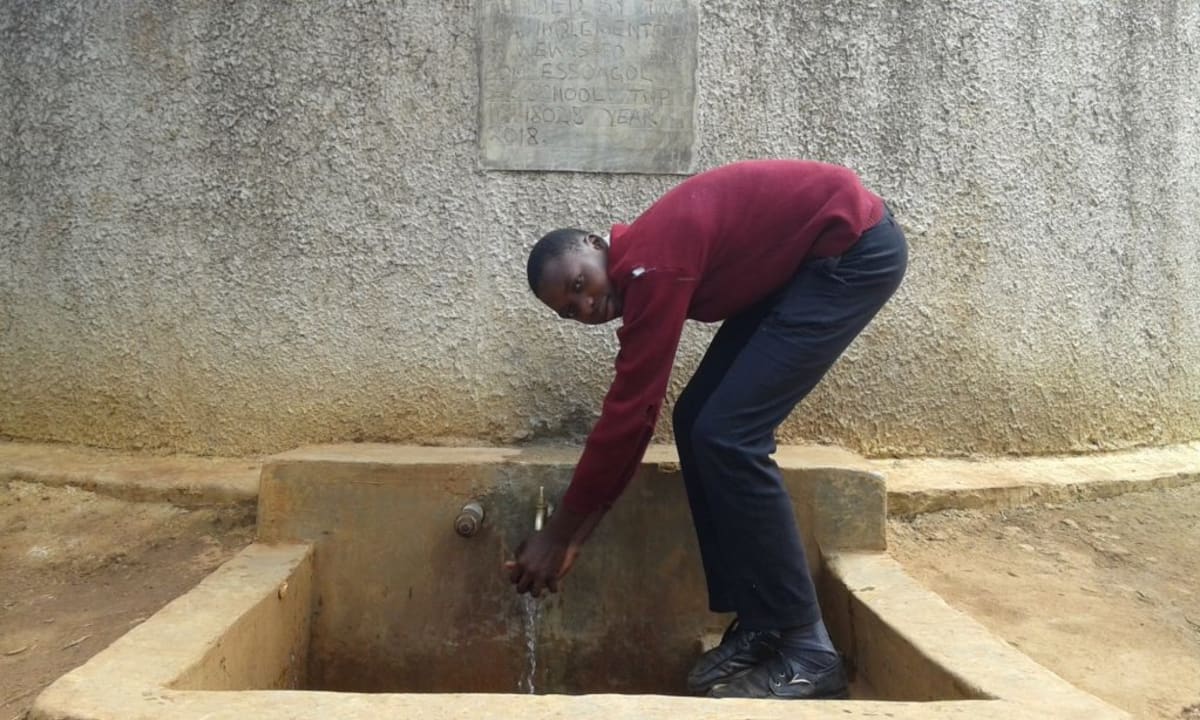Essong'olo Secondary School was established in 1985 but closed again soon after. It was revived by a new administration in 1994. The enrollment in its first year was just five students! Now the school hosts 566 students and employs 22 teachers and 12 support staff.
A normal school day begins at 8am and ends at 5pm. Students used to have an hour break to return home and eat lunch, but the school is now equipped with enough cooks to have lunch on school grounds.
Water
There are a couple of plastic rainwater catchment tanks of 2,000 liters each. Far too small for a school this big.
The administration admitted that students often go without drinking water after lunch. There is a severe water shortage here, and thirst causes students to struggle through their afternoon classes.
The cooks start their day by drawing the water they'll need for cooking because it's never guaranteed there will be water left by lunchtime.
Chairman of the school board, Mr. Job Osiako, said that the water situation in the surrounding community isn't good either.
"Many people still don't have access to clean water in this village. One spring in this neighborhood almost dries up during the dry months, making the villagers line up for a long time to get water. Waterborne diseases erupt during that season," he said.
Sanitation
The pit latrines here are filthy. The walls of the boys' latrines are falling apart and a lot of doors are barely hanging from their hinges. A student will usually bring a friend to the latrines to hold the door closed for privacy. There is a handwashing station, but it's reserved for school staff.
Here's what we're going to do about it:
Training
Training will be held for two days. The facilitator will use PHAST (participatory hygiene and sanitation transformation), ABCD (asset-based community development), CTC (child to child), lectures, group discussions, and handouts to teach health topics and ways to promote good practices within the school. The CTC method will prepare students to lead other students into healthy habits, as well as kickstart a CTC club for the school.
Handwashing Stations
The CTC club will oversee the new facilities, such as handwashing stations, and make sure they are kept clean and in working condition. The two handwashing stations will be delivered to the school, and the club will fill them with water on a daily basis and make sure there is always a cleaning agent such as soap or ash.
VIP Latrines
Two triple-door latrines will be constructed with local materials that the school will help gather. Three doors will serve the girls while the other three serve the boys. And with a new source of water on school grounds, students and staff should have enough to keep these new latrines clean.
Rainwater Catchment Tank
A 50,000-liter rainwater catchment tank will help alleviate the water crisis at this school. The school will also help gather the needed materials such as sand, rocks, and water from the spring for mixing cement. Once finished, this tank can begin catching rainfall that will be used by the school’s students and staff. Students will no longer have to worry about having enough water to get through the school day.
We and the school strongly believe that with this assistance, standards will significantly improve. With clean water and high standards of cleanliness, students’ good health will give them the chance to earn better grades and live a better life.
This project is a part of our shared program with Western Water And Sanitation Forum (WEWASAFO). Our team is pleased to provide the reports for this project (edited for readability) thanks to the hard work of our friends in Kenya.

 Rainwater Catchment
Rainwater Catchment
 Rehabilitation Project
Rehabilitation Project

































